A Photographic Journey with Yuri Dojc
Can the Holocaust be memorialized by an aesthetically beautiful object? Doesn’t the obscenity of the crime create a fundamental contradiction? The question still stands 66 years later, even as art is still being made about the Holocaust. Jewish creativity seeks to smother hate. But the questions persist: can a memorial ignite hope instead of despair?
This is the challenge of Holocaust art and this is the deeply beautiful response of Yuri Dojc’s photographs of the remnants of Slovakian Jewry, currently on view at the Museum of Jewish Heritage.
The Last Folio is not an exhibition of photographs. At its most basic it is four distinct aesthetic experiences (installation, video, images themselves, catalogue) focused on one riveting reality: the destruction of the majority of Slovakian Jewry during the Shoah. The installation at the Museum of Jewish Heritage is a theater piece; a tableau vivant, in which the photographs of Yuri Dojc are used to create set pieces for visual meditation. In the Rotunda Gallery the celebrated designer Daniel Weil (who revitalized the archeological wing of the Israel Museum) has utilized the five exhibition bays to focus on five subjects in Dojc’s images: Ruins, Cemetery, Synagogue, Synagogue Ceiling, Synagogue Interiors. The themes, expressed by two blow-up images as background and three floating images in the foreground, are broadly interpreted. For example, Synagogue Interiors also have images of tefillin straps and parchments that formerly were inside tefillin, therefore another kind of interior image of a sacred space.
The rotunda is approached by a narrow passageway that serves as the visual and emotional entrance to the exhibit. Twenty-eight riveting images of Slovak Jewish survivors are embedded in the entrance walls and ground the exhibit in a contemporary reality; one that is aging and quickly fading away. Effectively we can only see the past through their eyes.
A six-sided tower of photographs directly under the skylight dominates the rotunda space. This is the tower of Jewish texts, a shattered library of 24 images of Jewish books Dojc found and lovingly photographed among the remains of Jewish life in Slovakia. Each image is a portrait of a ruined Hebrew text; simultaneously a dirge on the destruction and a celebration of the Jewish study that lives on. Jewish study, knowledge and practice thrives with these very Jewish texts devotedly studied and prized throughout the Jewish world today. As you glimpse these texts, fragments of Prayer Books, Torah, Psalms and Talmud, you realize the link between the ruins of the Holocaust and the living world of today’s Judaism. This is the jolt of inspiration that animates Daniel Weil’s installation of Yuri Dojc’s photographs.
Integral to the installation is a nine-minute video by renowned independent television producer/director Katya Krausova (winner of 1997 Best Foreign Language Film Oscar Kolya). The film integrates Dojc’s images with the three-year experience of searching out the length and breath of Slovakia (17 different locations) for remnants of Jewish life. It is an intensely personal narrative, revisiting where his own parents were hidden and interviewing a member of the family who saved them. His story slowly unfolds, mostly through the eyes and memories of others and their descendants. Paradoxically his own history emerges through the detritus of the history of others. But it is a race against time as more and more history disappears through decay and the death of those who could remember. Finally in an old house that contained a cache of Jewish books from Eastern Slovakia, Dojc stumbles upon a Machsor belonging to Jakub Deutsch, his grandfather. His work is now done. He feels this book truly belongs to him and that finding the book finally completes his journey.
Yuri Dojc was born in Slovakia. Then as a teenager he found himself as a refugee from his homeland and finally blossomed into a successful commercial photographer in his adopted country, Canada. He is internationally lauded as a professional photographer for his commercial and extensive portrait work. In 2005 he began work on what would become the Last Folio, a project that would consume him for at least three years. Without doubt the best place to view these exquisite photographs is online at lastfolio.com. Here the work is thematically divided; Books, Buildings, Cemeteries, Fragments, and Survivors. His compositional skill is awesome and only surpassed by his patience to allow the perfect expression to develop under his watchful eye.
Another place to really appreciate these photographs is the catalogue, “Last Folio: Textures of Jewish Life in Slovakia.” It has moving essays by David Marwell, director of the Museum of Jewish Heritage; Katya Krausova, the creator of the video; Lucia Faltin, historical scholar and the well-known author Azar Nafisi along with 56 stunning images from the project.
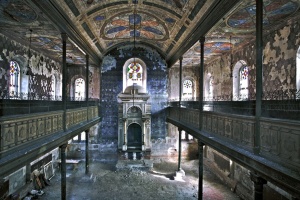
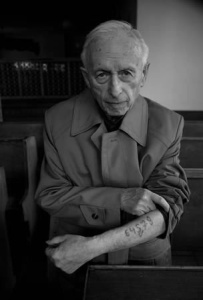
It is obvious that his photographic work in Slovakia involved constant interaction with the people: discussions, probing, questioning and lots of listening. Therefore when we see an image like Survivor 64579, we know it is much more than the result of a chance encounter. As is typical of Dojc, the forthright composition combined with the subject’s stark gesture commands this image. Similar in style is Synagogue Interior – Kosice (2006). Deceptively symmetrical at first glance, the image’s subtle asymmetry starts to break up our assumptions immediately. Clearly what once was an impressive place of sanctity is now a hopeless ruin. Even the stairs to the Holy Ark have been sold off to the highest bidder. The opulence of the remaining decoration screams against the decay and neglect of the abandoned house of worship.
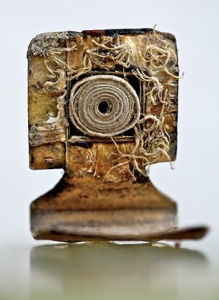
Equally shocking are his images of “Fragments.” Here we see knots of abandoned tefillin straps and a tefillin scroll tossed on a tabletop upside down in elegiac disarray. In a shockingly clinical focus Dojc photographs the inside of a head tefillin, discovered torn open to reveal the sacred scroll inside. The image is almost obscene. The desecration of this object deeply echoes its abandonment or the murder of its owner. There is a shocking violence to his images that cuts to the core of remembrance. We must not be passive when we remember.
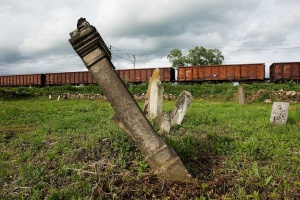
Cemeteries dominate many images, beguiling us with a corrosive romantic beauty. Dramatically tilted stones against cloudy skies whether in snow or against barren trees, the images are always compelling. Nonetheless one image trumps all of them. In Cemetery: Cerhov, 2006, the tilting tombstones are seen in a field with a rust-colored boxcar train rushing by. This juxtaposition, only possible through amazing patience on the part of the photographer, results in a searing image that addresses the chasm between murder and a natural death. The horror of the Holocaust is condensed in one image.
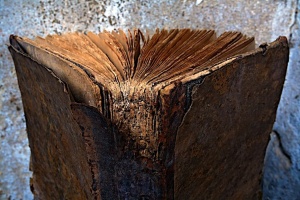
Dojc’s “portraits” of the thousands of sacred books he found scattered around Slovakia has effectively created a new category of portraiture. The objectification of these books has turned them into vehicles of emotion of what was lost while at the same time the glimpses of the Hebrew texts links us to contemporary Hebrew texts accessible to more and more Jews hungry to repossess their glorious heritage.
His journey may have been completed with the finding of his grandfather’s Machsor, but ours only begins with his terribly beautiful images. In terms of Holocaust art that connects with original content it is very late in the day. Much is irretrievably slipping away. Azar Nafisi’s essay ponders how art can possibly approach the enormity of the crimes against the Slovakian Jews. How can the victims be avenged? And yet she reasons; “Safeguarding their memory is in itself a form of justice, not only against the brutality of man, but also against the cruelty of time.” Further she asserts that the “resilience of the human spirit is not a mere fable. As in all great art, Yuri Dojc’s photographs mourn the tragedy of those lost lives, but celebrates them as well…” Indeed it is the intense beauty of his images that assures that we will not forget the Jews of Slovakia. Their memorial will last as long as we are able to see Yuri Dojc’s images and know that, at least here, beauty can overcome evil.
Last Folio: A Photographic Journey with Yuri Dojc
Museum of Jewish Heritage
A Living Memorial to the Holocaust (mjhnyc.org)
36 Battery Place, Battery Park City, N.Y., N.Y.